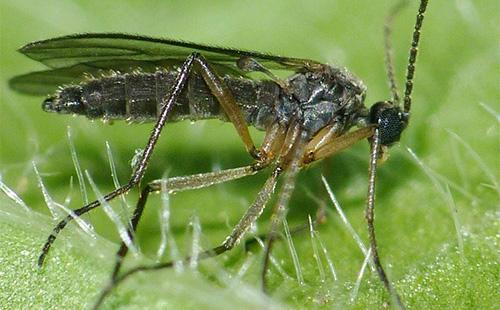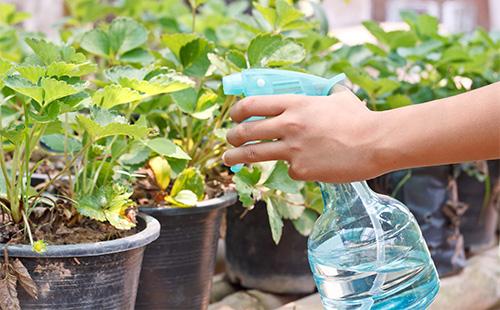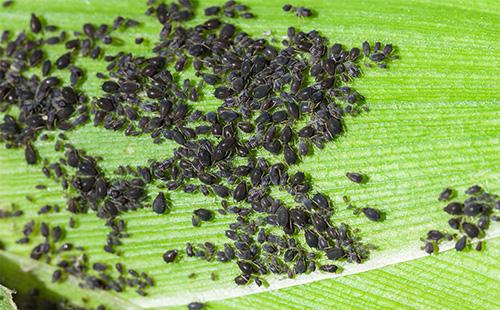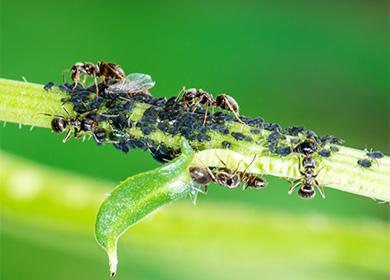The content of the article
Florists use chemical and folk remedies to combat flying insects and their larvae. But before taking action, you need to determine which pest you are dealing with.
Description of flying insects
On indoor crops can live several types of midges. Some damage the roots, others the aerial part of the plant. There are midges that are completely safe and even useful. The following are the midges that wind up in room colors most often and which need to be etched.
Whiteflies
Small white midges no more than 3 mm in length. Their wings are covered with a plaque that resembles flour. If you touch the plant, pests take off from it. Whiteflies usually hide on the underside of the leaf; larvae are also laid there. The lower leaves are covered with feces of midges - sticky honey dew.
A greater danger than the insects themselves is a sooty fungus. It develops in places where sticky plaque accumulates. Whiteflies are also carriers of viral diseases - curly leaves, yellow mosaics. Larvae feed on plant sap, leading to growth retardation, shoot deformation.
Mushroom mosquitoes
Scientifically, they are called sciarids. An adult insect is a black fly up to 4 mm long. Sciarides lay eggs in the soil, near the roots. Of these, worm-shaped larvae develop that feed on the thin young roots of the plant. Especially dangerous are the larvae of mushroom mosquitoes for seedlings, recently rooted cuttings.
Earthen midges in indoor flowers actively reproduce in conditions of constant dampness, if the plant is watered too abundantly, or there is no full drainage. Young mosquitoes are small, translucent - at this stage they are not yet dangerous.
A plant with damaged roots withers, stops growing, stops flowering. With severe damage to the roots, the flower dies. If you get it from the pot, translucent larvae with a black head will be visible to the naked eye.
Blackbird
Thrushes are fruit flies. Propagate on rotting vegetables and fruits, in fermented foods. They can appear anywhere under favorable breeding conditions.
Threats for indoor plants are not insects. Compared to mushroom mosquitoes, they are smaller. They do not gather directly next to the flowers, but fly throughout the apartment.
Lacewing
Small green midges. Their wings are almost transparent, with a pronounced mesh. In apartments are quite rare. Appearance is possible if mosquito nets are not installed on the windows. The laceworm larvae are predators; they do not pose a threat to indoor flowers.
Adults do not always exterminate insects. Their favorite food is sticky aphid, pollen, and nectar. But the laceworm larvae are called "dead lions." They are able to exterminate a large number of aphids. Outwardly resemble the larvae of ladybugs.
Lacewings lay eggs on the leaves. It is very easy to recognize the masonry - each egg is held on a separate hair-like thread. If lacewings have chosen indoor plants, the leaves must be inspected for the presence of aphids.

Causes of Pests
You should always try to immediately establish the cause of pests in order to permanently remove them. It will be easier to get rid of them if you eliminate the source of the problem. There are mainly three factors leading to the appearance of midges.
- Dampness. Excessive irrigation with poor drainage cause fluid stagnation, acidification of the substrate. In such conditions, sciarids feel comfortable, quickly develop and multiply.
- Open windows. If there are no mosquito nets on the windows, pests quietly penetrate the house.
- Contaminated soil. Old soil, land from the garden, non-sterile store soil may already contain insect eggs. Therefore, before planting, the soil must be calcined, watered with potassium permanganate.
How to get rid of midges in indoor colors with chemicals
If midges appeared and there are a lot of insects, you have to use insecticides. Sometimes this is the only effective way against pests. For humans, they are practically non-toxic, safe for flowers. The five most popular are considered the most popular.
- "Regent". An effective remedy that helps against all types of midges. The drug must be dissolved in water according to the instructions, water the soil with it.
- Aktara. With a solution prepared from the product, you need to water the soil, at the same time spray the plant. Actara is effective against adult insects and their larvae.
- Inta-vir. The drug is sold in the form of tablets or powder. It is dissolved in water, used for watering, spraying.
- "Actellic". Effective against all pests. The only negative is that it is undesirable to use it during flowering.
- Agravertin. The solution of this drug helps mainly from adult insects - it kills and scares them away. Larvae do not die.

How to fight folk remedies
If you do not want to use chemicals, you can treat indoor flowers from midges with folk remedies. They are completely safe, but it is advisable to use them only with a small number of insects. The following are considered the most effective means of removing insects.
- Matches. Heads next to the plant stick a few matches, slightly moisten the soil.From time to time, matches are taken out and checked - if sulfur is completely dissolved, replace with new ones. The procedure is repeated several times until the flower midges disappear completely.
- Potassium permanganate. Make a weak pink solution of potassium permanganate, used for watering. They cultivate the soil several times. The minimum time interval between watering is two days.
- Ammonia. In a liter of water, 10 mm of ammonia is diluted. The resulting product is watered and sprayed several times at intervals of seven to ten days. A solution based on ammonia scares off adult insects, destroys larvae, and saturates the soil with nitrogen.
- Activated carbon. Several tablets are crushed into powder, they are sprinkled with soil in a pot. The procedure is repeated for five days. It helps in cases where there are very few midges.
- Ash. Fine wood ash dusts the surface of the soil in a pot. He does not kill the larvae, but repels adult insects - whiteflies and mushroom mosquitoes. Also, the ash performs the function of additional feeding.
- Dill. Dill seeds are scattered on the surface of the soil. The layer is changed every two days. Continue the procedure until the midges disappear completely.
- Citrus. Pieces of orange or lemon peel are stuck into the soil at a distance of 5 cm.
- Garlic. An infusion is prepared - three heads of garlic are grated, poured with a liter of boiling water. After four hours, filter, spray the plant and water the soil. To get rid of mushroom mosquitoes, two procedures are enough.
Many folk remedies for midges in indoor flowers, cooked at home, really help. But they are usually used with a small number of insects. In advanced cases, it is better to immediately use insecticides.

Prevention
Getting rid of midges can be difficult. Therefore, it is better to immediately carry out a series of preventive measures. The following guidelines are recommended.
- Purity. Fallen, diseased leaves and flowers are immediately removed. They attract Drosdophilus, contribute to their reproduction.
- Moderate watering. Even hygrophilous cultures do not tolerate stagnation of water in the root system. The likelihood of rot development increases, the soil is salted, acidifies, favorable conditions are created for the propagation of mushroom mosquitoes. Provide good drainage, watered only after the soil surface has dried.
- Soil treatment. Before planting, the soil must be sterilized. Usually it is calcined in a pan, watered with a solution of potassium permanganate. Some gardeners recommend freezing the substrate before use - at low temperatures, all the larvae die.
- Fertilizers. It is not recommended to use used tea leaves, food residues as an organic fertilizer. The rotting process attracts Drosdophilus.
- Mulching. The surface of the soil in the pot is covered with sand or perlite. Mulch does not interfere with root respiration, protects the earth from mushroom mosquitoes.
- mosquito net. They close the windows and windows with a small mosquito net so that mushroom mosquitoes and whiteflies can not enter the house.
Knowing how to remove midges in indoor flowers, you can slow down their reproduction in time. Many first use folk remedies, with their ineffectiveness they switch to chemical preparations. But the main rule of a successful struggle is the elimination of the root cause.

